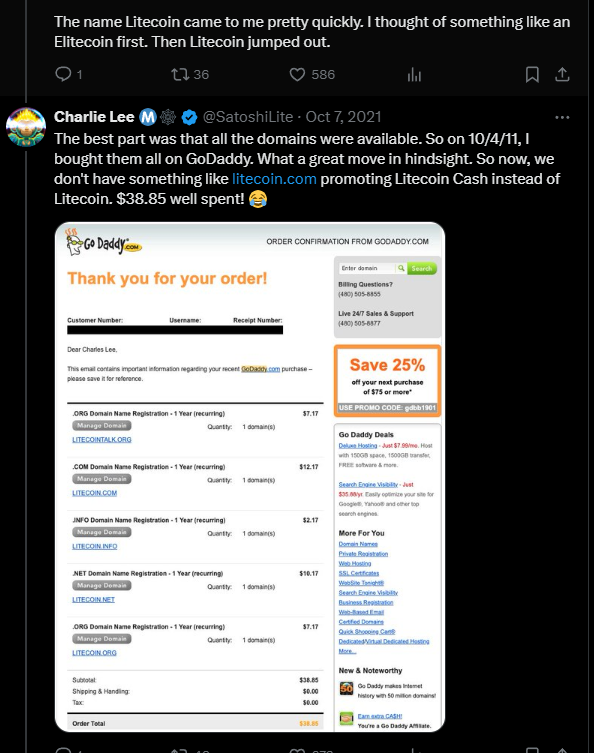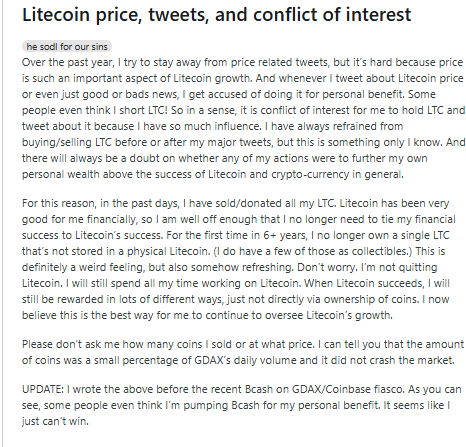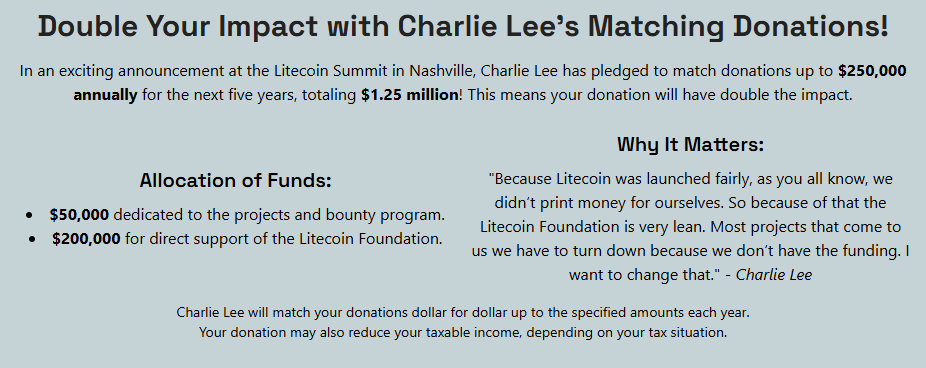Charlie Lee, the computer scientist who created Litecoin, is one of the most influential figures in the crypto industry. As the founder of one of the earliest and most successful Bitcoin derivatives, Lee has built an impressive career and fortune. As of 2025, Charlie Lee’s net worth is estimated at over $300 million.
Under Lee’s leadership, Litecoin has maintained a strong position in the crypto space. After almost 15 years, it remains one of the largest cryptocurrencies in the world even today, an unheard-of accomplishment in the crypto sphere, rivaled only by Bitcoin itself.
In this article, we will tell you all about the software engineer behind Litecoin, his rise to fame, and the details of his net worth.

Breaking Down Charlie Lee’s Net Worth in 2025
Here is a breakdown of Charlie Lee’s estimated net worth based on publicly available information (and a lot of speculation). The exact figures for his crypto holdings remain a mystery. However, based on his involvement in Litecoin’s creation and the potential value of his assets, it is safe to estimate that his net worth exceeds $300 million as of 2025.
| Asset or Income Source | Contribution to Net Worth |
|---|---|
| Tech salaries | Undisclosed |
| LTC holdings | Sold in 2017 for undisclosed amount |
| Other crypto holdings | Undisclosed |
| Total Net Worth | $300+ million |
Charlie Lee Net Worth: Early Life and Education
Charlie Lee was born on January 5, 1977, in the Ivory Coast. His father was among the first Chinese people to settle in Africa during that period. When he was 13 years old, his family moved to the United States, where he graduated from the Lawrenceville School, a prep school in New Jersey, in 1995.
Charlie Lee has a brother, Bobby Lee, who is the founder and CEO of the crypto exchange BTC China.
After high school, Lee studied at the Massachusetts Institute of Technology. He obtained a Bachelor’s degree in computer science in 1999 and a Master’s degree in computer science in 2000. Lee maintains a relatively private personal life, so there is limited information available about him beyond his professional endeavors.
Charlie Lee’s Career and Financial Success Over the Years
After earning both his Bachelor’s and Master’s degrees from the Massachusetts Institute, Lee embarked on a career that included positions at various prominent companies. It wasn’t until 2011 that he developed Litecoin while still working at Google. Let’s see how his career progressed over time.
Early Career
Starting from 2000, Charlie Lee started his work in the technology industry. He worked at Kana Communications, Guidewire Software, and Google, where he contributed to projects like YouTube Mobile and Chrome OS. He remained with Google from 2007 to 2013, though his salary and other details from that period remain undisclosed.
Lee’s First Attempt at Copying Bitcoin
Lee shared that he first learned about cryptocurrency in 2011 when he read an article about Silk Road, an online marketplace that was mostly used to sell illegal goods and services, which only accepted Bitcoin payments. He was already skeptical of the Federal Reserve System at the time, so he was already searching for investment strategies that were less reliant on central banks. This article soon became the focus of his next project – and the source of his wealth and fame.
Similar to other developers who were eager to copy Bitcoin at the time, Lee’s first cryptocurrency project was a failure. He succeeded in his second attempt, though, creating Fairbix, a blockchain payment system. Fairbix was developed by cloning the source code from Tenebix. Even though it was initially a success, it unfortunately crashed within only a few weeks of its release, most likely because of a bug regarding transaction scams.
Below, you can see Lee’s announcement on BitcoinTalk about the relaunch of his Fairbix project:

The Birth of Litecoin
In 2011, while still at Google, Charlie Lee developed Litecoin as a “lighter” alternative to Bitcoin. He designed it as the “silver to Bitcoin’s gold.” His idea was to create an altcoin that offers faster transactions and lower fees. He released Litecoin to the public after mining only 150 coins, which ensured a fair distribution from the outset.
In a 2021 X post, Charlie Lee (@SatoshiLite) shared the story of how he created Litecoin. In the story, which he shared in comments, he told his followers that he spent $38.85 to buy all the Litecoin-related domains on GoDaddy:

“I worked on the code for a few days. To be honest, Litecoin was not hard to code up. The hardest part was actually to create the genesis block. Satoshi never documented how he did it, and the code to do that was not checked in with the Bitcoin source code,” – he explained.
On 10/8/2011, Lee announced Litecoin to bitcointalk.org, which, according to him, was the only place that people chatted about Bitcoin back then. The code was available for everyone to download.

Lee’s story continues in detail in the X post, where Lee describes how he came up with Litecoin’s logo, how it was added to Bitstamp, and more.
In a recent interview with podcaster Peter McCormack, Charlie Lee mentioned that Litecoin was originally created as a side project for fun, with no major expectations. He didn’t anticipate Litecoin’s success, but his project ended up gaining significant traction and evolving into its own entity. You can watch the full interview from the 2024 Litecoin Summit here:
McCormack argued that much of Litecoin’s early success could be attributed to its utility as a fast and cheap bridge between platforms. When traffic on Bitcoin was especially high, investors would convert their BTC to Litecoin, move it, and then convert it back – all because of its faster transaction times.
On top of that, Litecoin acted as a “test bed” for Bitcoin technologies, meaning that the new features and changes were tested on Litecoin before they were implemented on Bitcoin. One such example is the implementation of the important SegWit upgrade on Litecoin before it was adopted by Bitcoin.
Litecoin’s Success Over the Years
Litecoin is a fork of Bitcoin, meaning that it was created by copying and tweaking Bitcoin’s open-source code, turning it into a separate cryptocurrency. Lee designed Litecoin to make LTC more spendable than BTC by increasing the maximum circulating supply, lowering transaction fees, and significantly reducing block production time. Litecoin can produce blocks four times faster than Bitcoin, and it has a maximum circulating supply of 84 million LTC compared to Bitcoin’s supply of 21 million BTC.
In 2013, Lee left Google and joined Coinbase as an Engineering Manager, working closely with the founders Brian Armstrong and Fred Ehrsam. Not long after, he was promoted to Director of Engineering at the company. Still, he left Coinbase in 2017 to focus full-time on the promotion of Litecoin, and on his work as Director of the Litecoin Foundation.
As of early 2025, Charlie Lee continues to serve as the Director of the Litecoin Foundation. He also holds a position as an independent Director at BTCS, a publicly traded digital asset and blockchain company.
Today, Litecoin is one of the top 10 cryptocurrencies by market capitalization, valued at over $10 billion. As for Lee’s ownership, he doesn’t hold a significant stake in the company, partly because Litecoin is not a traditional company. It is an open-source cryptocurrency, and Charlie Lee, like other creators of decentralized projects, doesn’t own it like a private company founder would own shares.
In July 2024, Charlie Lee made a public commitment to donate up to $250,000 a year to the Litecoin Foundation for the next five years, which adds up to a total of $1.25 million over the five-year period.
Litecoin Foundation matching donations | SOURCE: Litecoin.com
Charlie Lee’s Crypto Holdings
In 2017, Charlie Lee disclosed that he had sold (or donated) all of his Litecoin holdings at the time, citing a conflict of interest. He did, however, share that he retained a few physical Litecoin coins as collectibles.
Here is what he wrote on Reddit at the time:

Since Charlie Lee sold his Litecoin holdings back in 2017, he hasn’t revealed anything about repurchasing or currently holding any LTC today. At the time, LTC was valued at around $350-$370 per coin.
By the end of 2017, roughly 54 million LTC had been mined. However, Charlie Lee hasn’t publicly disclosed the exact amount he held at the time. Still, as the Litecoin founder, he likely held a large portion of the available coins. If he sold about 1 million LTC at the time (and he may have had significantly more), this would have added between $350 million and $370 million to his net worth.
In the week Lee sold his LTC holdings, over $3.4 billion worth of Litecoin was traded on GDAX. If his stake represented 1% of the trading volume on GDAX, that would mean that he got $34.8 million for selling his Litecoin. However, it is more likely that Lee’s stake was closer to 10% of the weekly trading volume – or 1 million LTC, which was worth over $350 million at the time.
Still, this is all subject to speculation since we don’t know how much he had, sold, or donated at the time.
In CNBC’s Fast Money interview from August 2018, Charlie Lee discusses his decision to sell his Litecoin holdings and shares insights on the crypto market:
Charlie Lee has mentioned in interviews and public statements that he has a diverse portfolio of cryptocurrencies. However, he has been cautious not to disclose specific information about his assets.
What Can We Learn from Charlie Lee’s Success with Litecoin?
Charlie Lee’s journey with Litecoin and blockchain technology offers several key lessons for innovators and aspiring entrepreneurs. First and foremost, his ability to identify market gaps and innovate played a crucial role in Litecoin’s success. He recognized the need for a faster and more scalable alternative to Bitcoin. Using his knowledge and vision, he created a cryptocurrency that addressed a specific issue, which helped advance Litecoin and make it stand out in a crowded market.
Another important lesson of his journey is the value of starting small, even when you have a wide-ranging vision. Lee didn’t launch Litecoin with the intention of it becoming a major player in the crypto space. Instead, he launched it as a passion project, all while working at a different company.
Lee’s story shows that even humble beginnings can lead to great success – and that true innovation often starts as a passion pursuit.
Finally, transparency and integrity have been critical to Lee’s reputation. His decision to publicly disclose his sale of Litecoin holdings was controversial, but it was also a clear example of his commitment to the project’s long-term success over personal financial gain.
FAQ
What is Charlie Lee's net worth in 2025?
Charlie Lee's net worth is estimated to be over $300 million in 2025, based on his contributions to Litecoin and other crypto holdings.
Does Charlie Lee own any Litecoin?
Charlie Lee sold all of his holdings in Litecoin in 2017, citing a conflict of interest. He hasn't publicly disclosed any current holdings.
What is Charlie Lee's main source of wealth?
Charlie Lee's wealth primarily comes from creating Litecoin, his work at other tech companies, and his ongoing involvement with the Litecoin Foundation.
Did Charlie Lee profit from Litecoin's success?
Yes. Lee likely profited millions when he sold his Litecoin holdings in 2017, although the exact amount is undisclosed.


